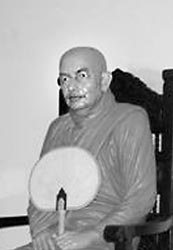
Kala KornerWalking into the newly opened Madihe Pannasiha Maha Nayaka Museum, one is ‘met’ by the excellent life size statue of the Thera. It is excellently executed. The obvious question is ‘who is the sculptor?’ No name is mentioned – he had not wanted his name anywhere.
The creator was a silent worker who had never met the Maha Nayaka Thera. He had not even seen him. Yet, he has done a perfect job with the help of photographs and other reference material. He had watched videos and observed the Maha Nayaka Thera’s expressions closely. These are well portrayed in his creation. Satyasri Wijendra hails from Weligama. When the search began for a sculptor to do the Maha Nayaka Thera’s statue, someone remembered the statue he had done earlier of the Thera at Meddewatte in Matara, a branch of the Sasana Sevaka Society. There was also a bust of the Maha Nayaka Thera done by “an unknown sculptor”. They managed to track him down and persuade him to undertake the job. “He finished it in double quick time taking just over a month,” the young monk at Sri Vajiragnana Dharmayatanaya who guided him, told me. “He is an unusual character. He only worked when there was no one around. If there were others watching him at work, he would stop and quietly move away. He had few wants. He never took rice during the entire period he worked. He was quite happy with a couple of biscuits for lunch.” Wijendra hardly spoke to anyone. He would only communicate with the young monk and that too sparingly. After finishing the job he had gone back and didn’t turn up even for the opening ceremony. As a person who had associated the Maha Nayaka Thera closely, when I got near the statue, I got the same feeling as I got when he was living. Every nuance of his had been captured perfectly. What hidden talent we have! Simplicity is the theme As for the museum itself, more work has to be done by way of organising the archives. On either side of the statue, the Maha Nayaka Thera’s scholarly achievements by way of certificates and scrolls are kept. A pictorial record of his journey adorns the walls. In a corner is the ‘pandu oruwa’ used to dye his robes. The room he used has been recreated. It’s a fine example of the simple life he led with the bare minimum of belongings. In the room is a Buddha statue he had worshipped morning and night every day for at least 60 to 70 years. He devoted all his time to either reading or writing. He used two tables – one is a tall one (it’s kept in a separate room) originally used by his ‘guru’ Pelene Sri Vajiragnana Maha Nayaka Thera where he used to stand and write. The other is a normal table. The cane chair where he used to sit and read is in a corner. One could see the simplest of beds he used with a clothes-hanger by the side. Once his library comprising his writings is brought in, it will be a boon for research students who will be able to delve into a wealth of information relating to the socio-economic conditions in the country over the past century, in addition to the religious topics he has covered. It is proposed to set up a fully equipped audio-visual centre as part of the archives. The Museum is a fitting tribute to a much revered monk whose service to the nation would be remembered for ever. |
|| Front
Page | News | Editorial | Columns | Sports | Plus | Financial
Times | International | Mirror | TV
Times | Funday
Times || |
| |
Copyright
2007 Wijeya
Newspapers Ltd.Colombo. Sri Lanka. |
